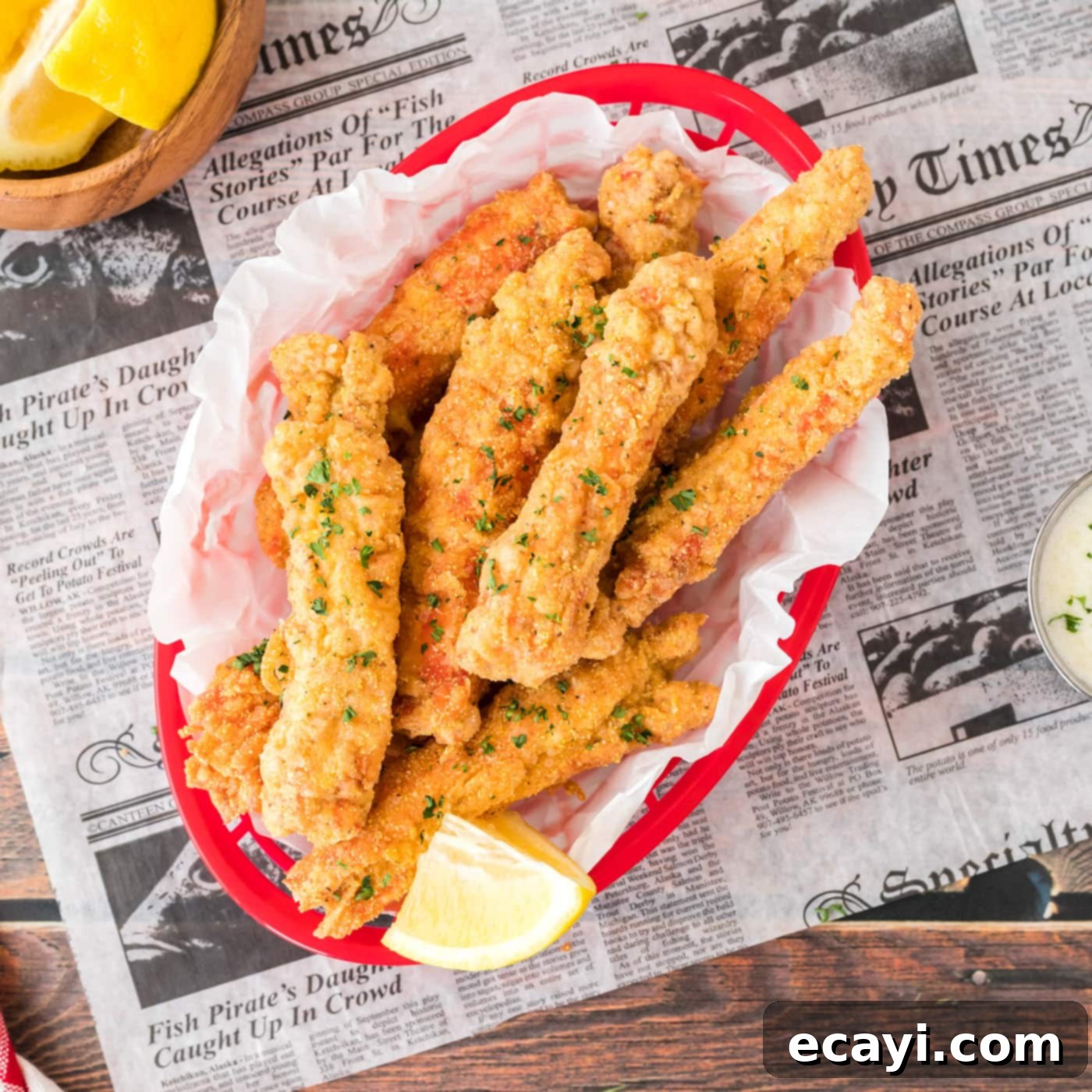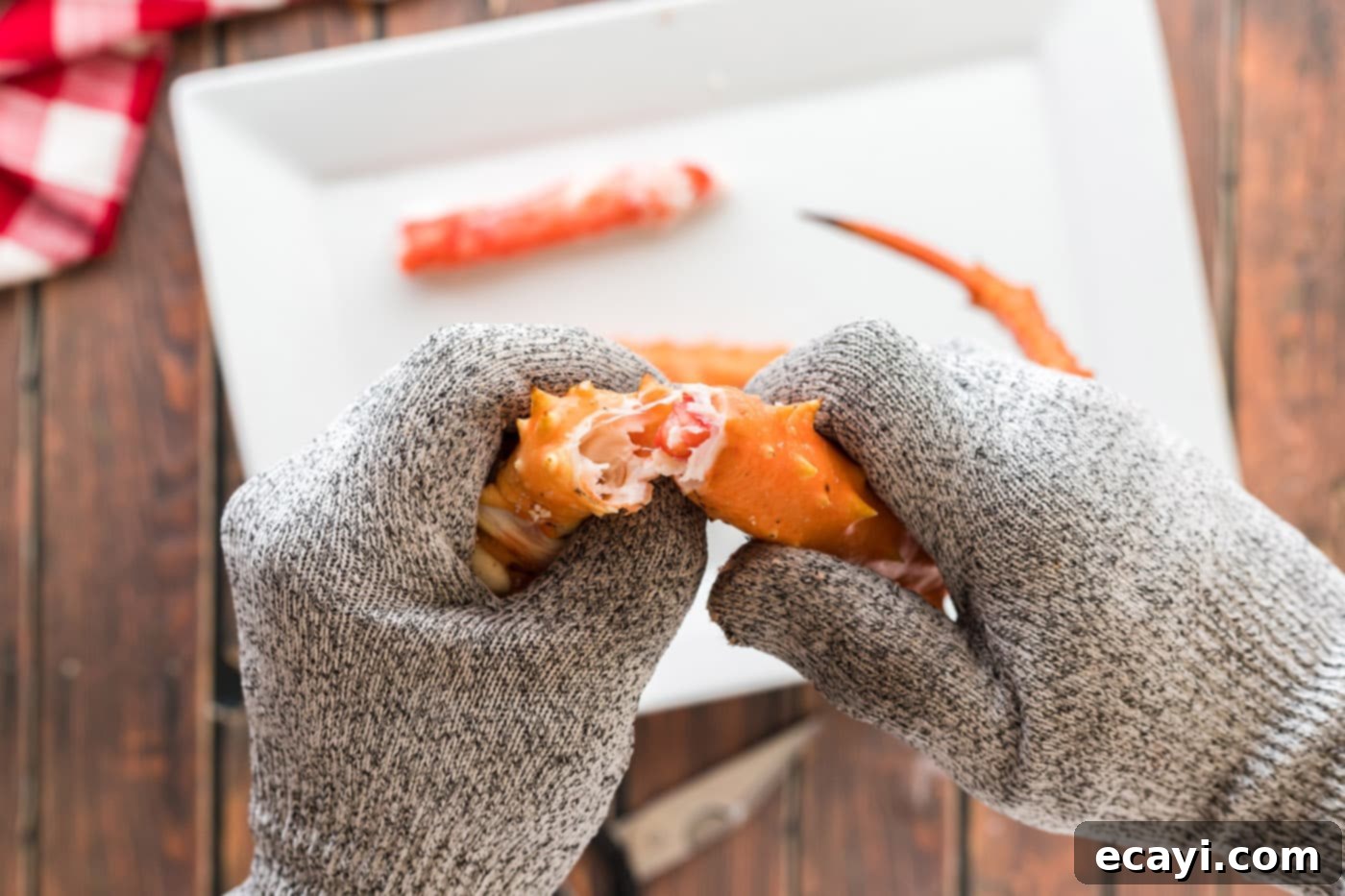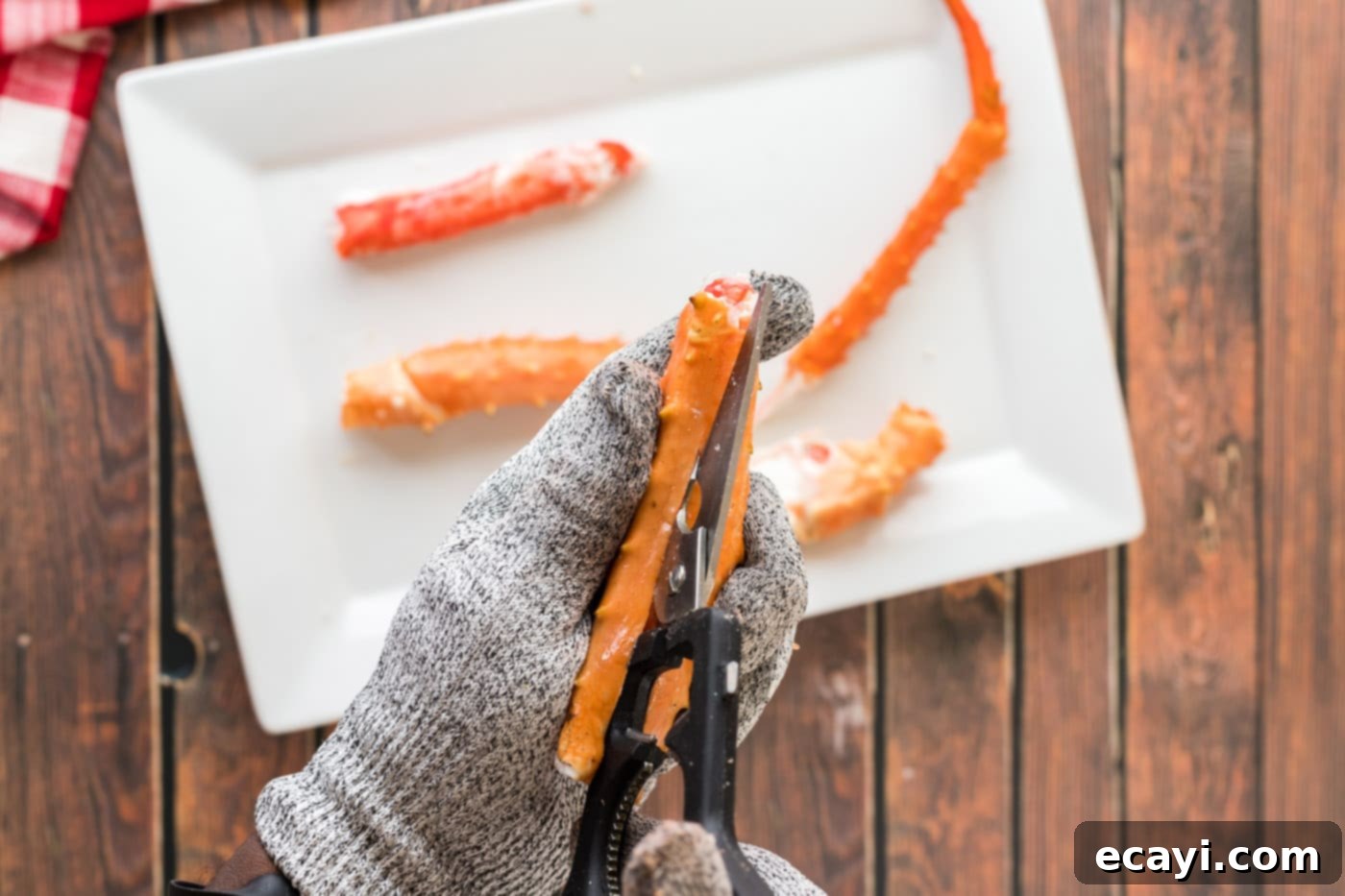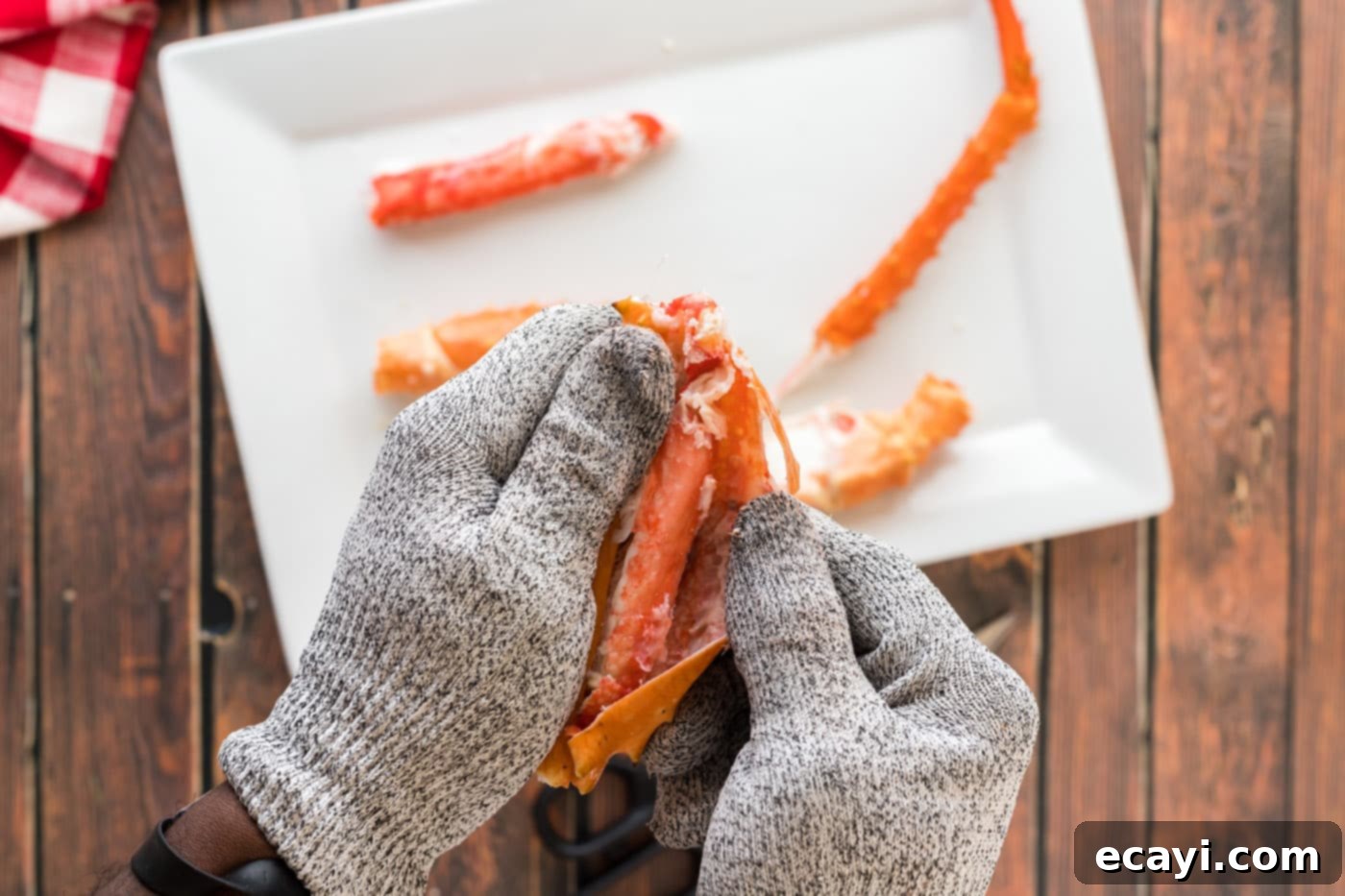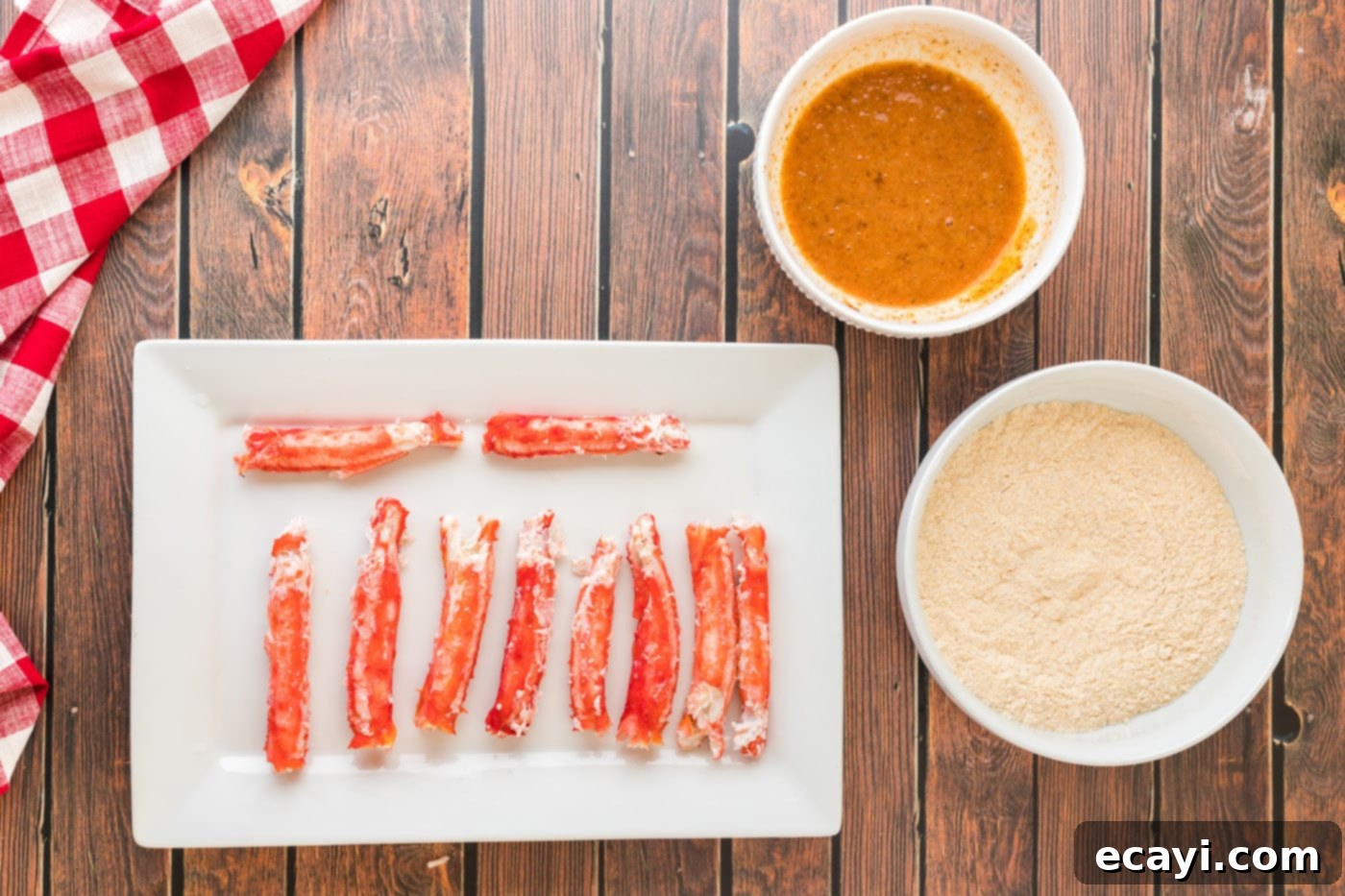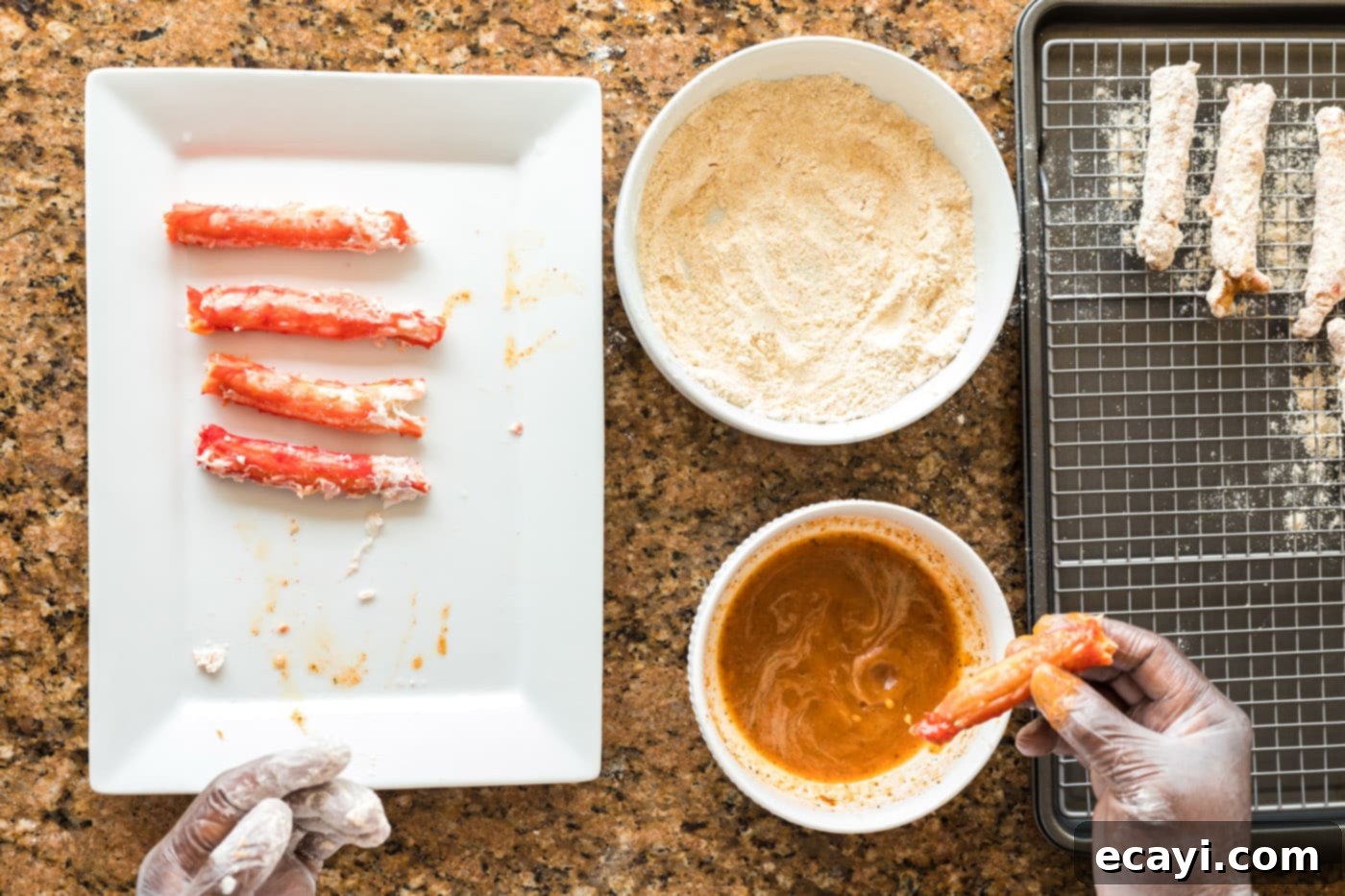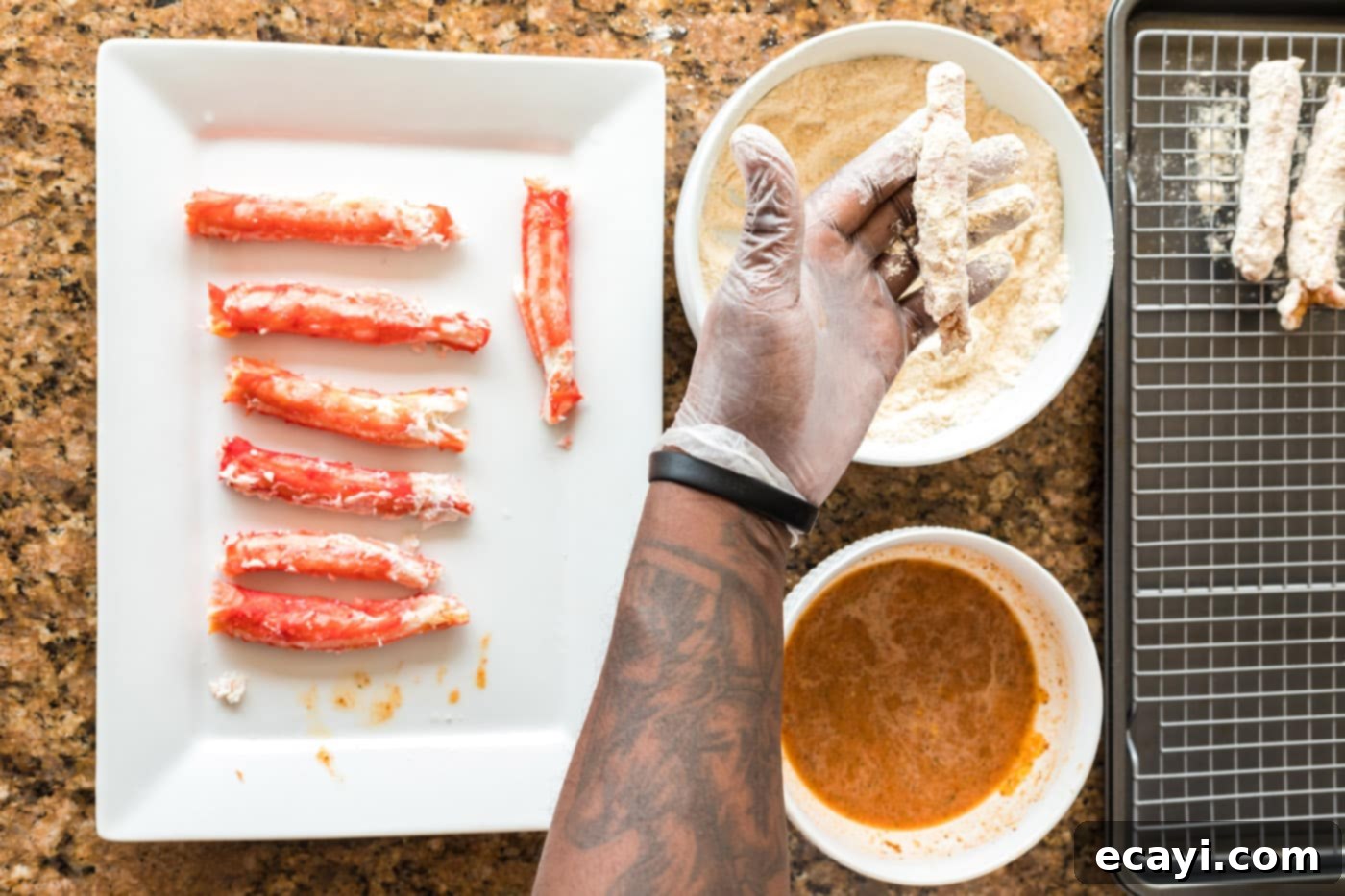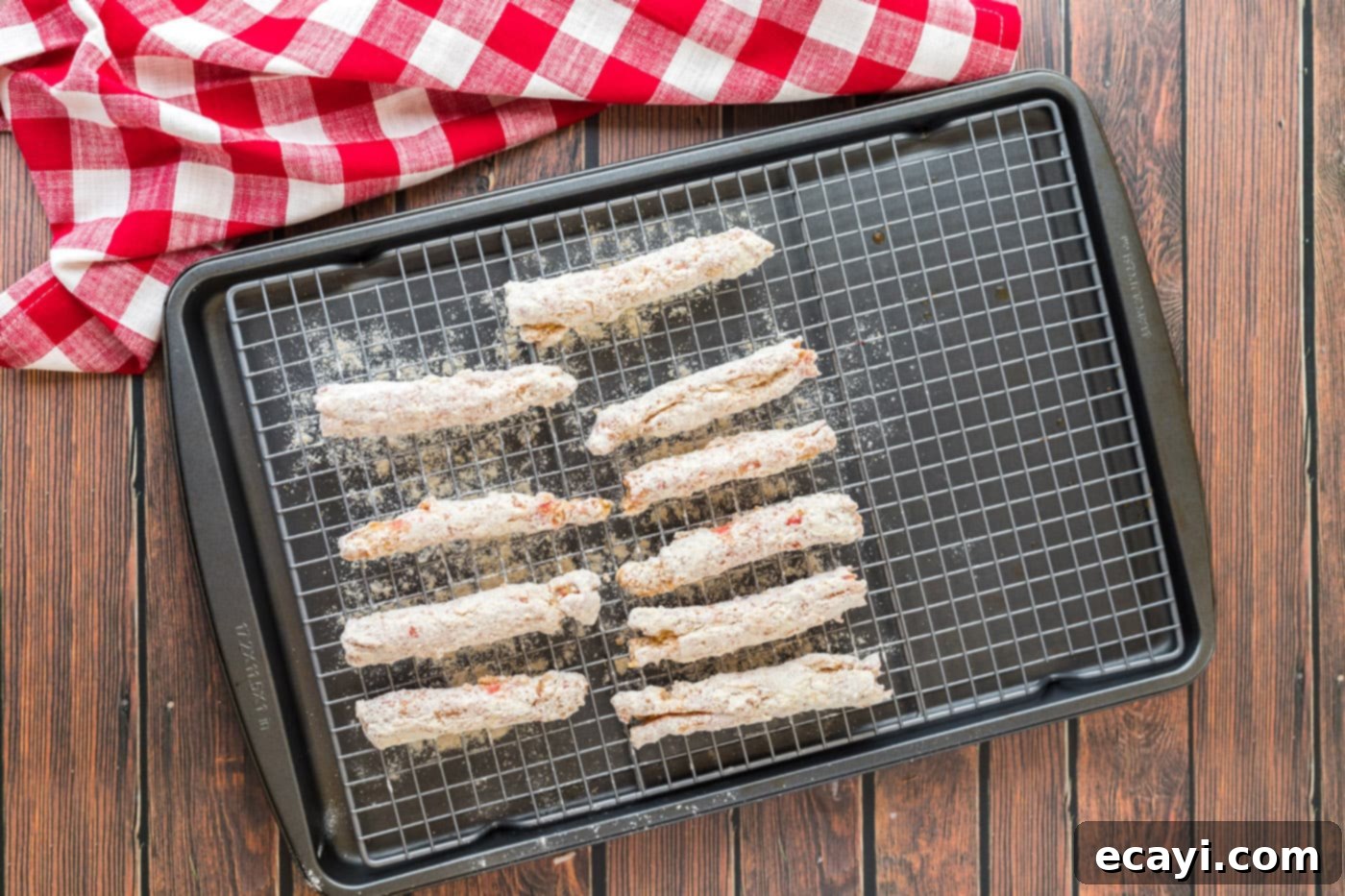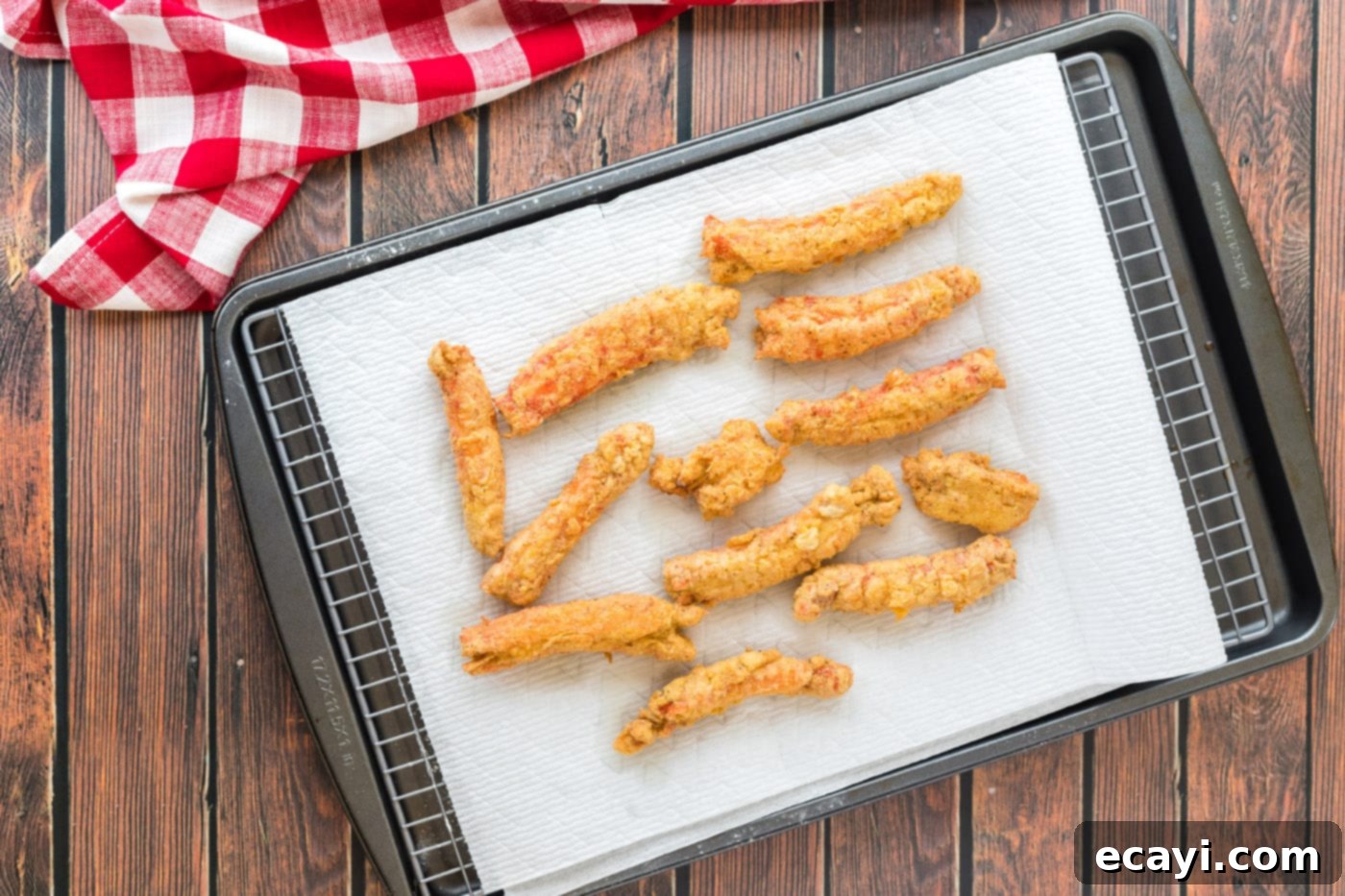Irresistibly Crispy Fried Crab Legs: Your Ultimate Guide to a Succulent Seafood Delight
Prepare to tantalize your taste buds with these sensational fried crab legs! We’re talking about succulent crab meat, expertly dunked in a perfectly seasoned cornmeal and flour batter, then deep-fried to achieve that coveted golden, crispy perfection. Best of all, this mouth-watering dish can be on your table in under 30 minutes, right from your stovetop. Forget fancy restaurants; you’re about to unlock the secret to homemade fried crab legs that will impress everyone.
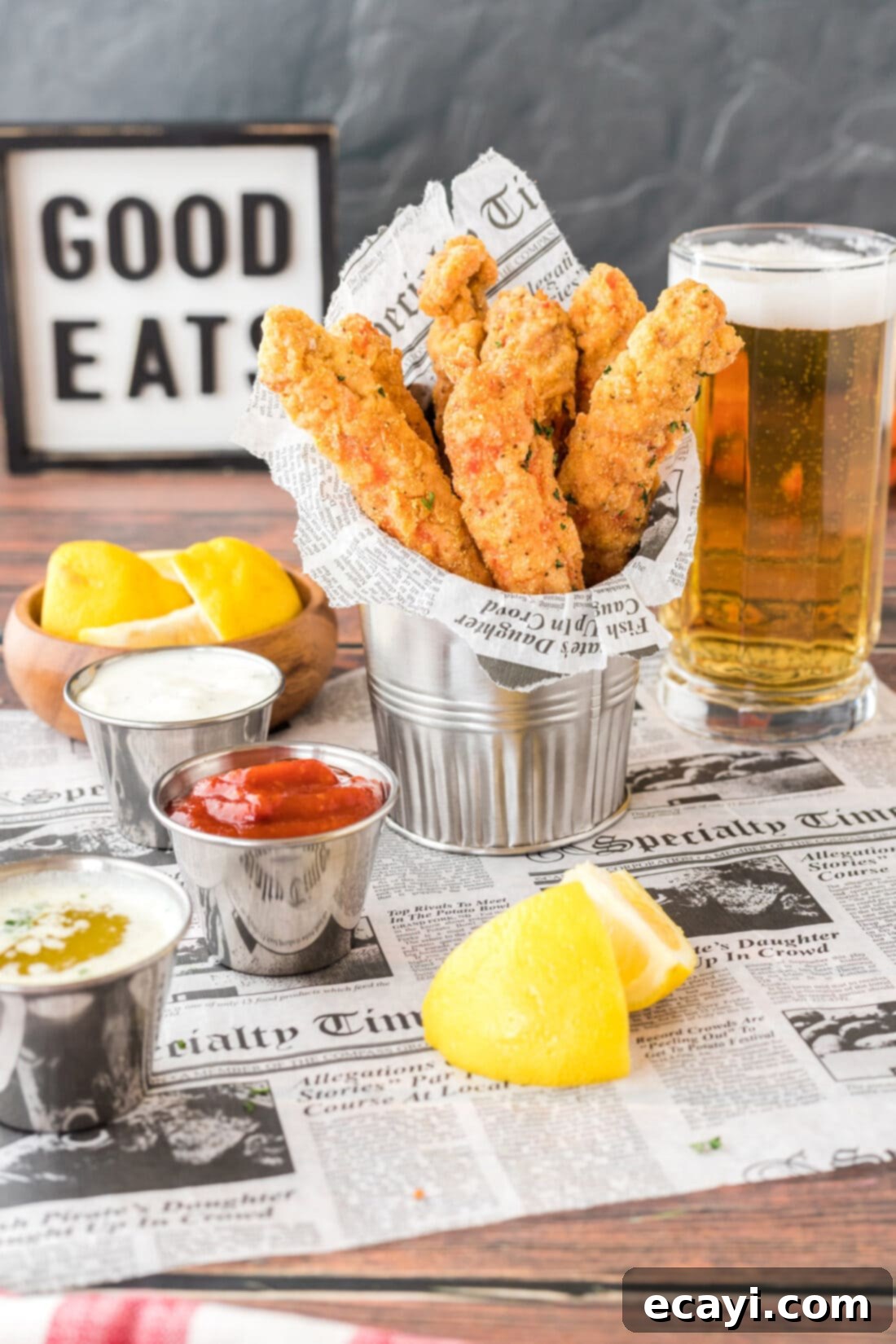
Why This Fried Crab Legs Recipe is a Must-Try
There’s nothing quite like the incredible textural contrast of perfectly fried crab legs: a tender, juicy, and incredibly succulent interior encased in an unbelievably crispy and crunchy exterior. This harmonious blend of textures, coupled with the rich, sweet flavor of fresh crab, makes for an unforgettable culinary experience.
While many crab recipes call for steaming or boiling, frying adds an entirely new dimension of flavor and satisfaction. The crispy batter locks in the moisture, ensuring every bite of crab meat is as juicy as possible, while the seasoned coating delivers an irresistible crunch and a burst of savory spices. It transforms crab legs from a simple seafood dish into an indulgent, restaurant-quality meal you can easily make at home.
For this recipe, we have a particular fondness for Dungeness crab legs for their fresh, sweet flavor. However, opting for King crab will provide you with even larger, more substantial pieces of incredibly juicy meat. Imagine these generous chunks of King crab, perfectly battered and fried into convenient, dippable seafood sticks, just begging to be paired with your favorite dipping sauces. Whichever crab you choose, the result will be a truly mouth-watering dish that celebrates the natural deliciousness of crab in a delightfully crispy form.
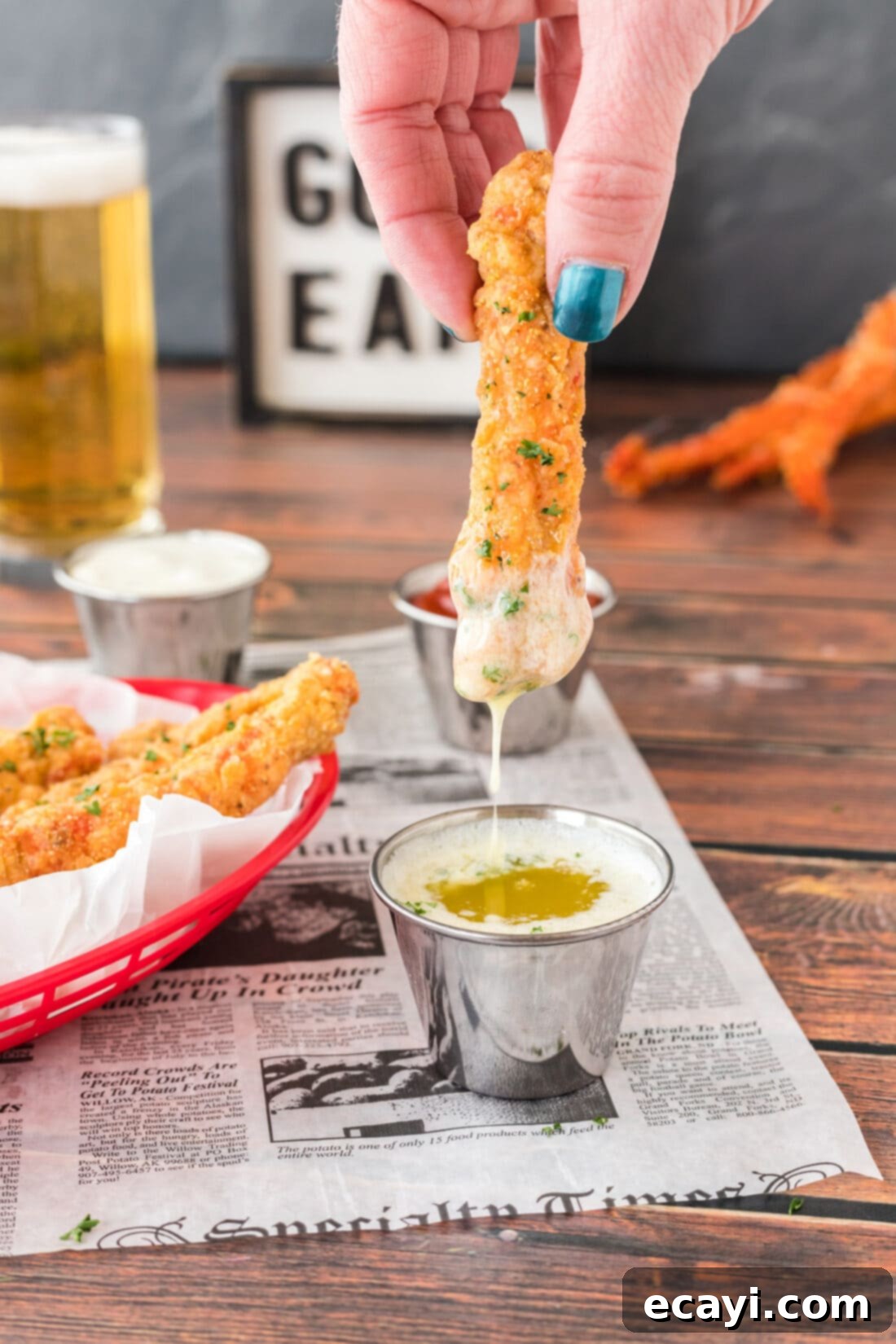
Essential Ingredients for Your Crispy Crab Legs
Crafting the perfect batch of crispy fried crab legs starts with selecting the right ingredients. Each component plays a vital role in achieving that sought-after flavor and texture. For a comprehensive list of all measurements and detailed instructions, refer to the printable recipe card available at the conclusion of this post.
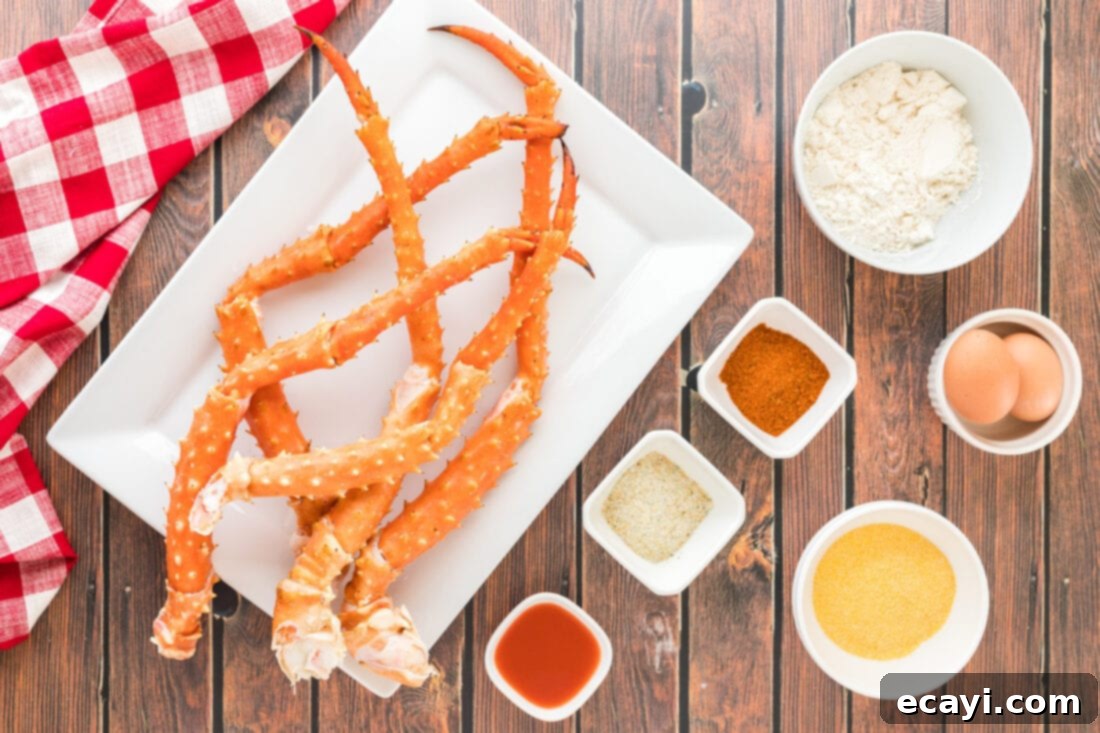
Ingredient Spotlight & Smart Substitutions
- Crab Legs: The star of our show! While you can use various types of crab, King crab legs are highly recommended for their substantial, juicy meat. They offer a luxurious texture and rich flavor that stands up beautifully to frying. However, their shells can be quite sharp and pokey. We strongly advise wearing cut-resistant gloves when handling and preparing King crab, as you’ll need to carefully cut open the shells to extract the pristine meat. This step is crucial for both safety and ensuring you get every delicious morsel.
- Important Note on Crab Legs: For this recipe, it is absolutely essential to use raw crab legs. Do NOT use precooked crab legs, as they will become tough and rubbery when fried. Raw crab meat will cook to tender perfection within the crispy batter.
- The Perfect Batter Blend: Our signature crispy coating is achieved by combining both all-purpose flour and yellow cornmeal. The flour provides a fine base that helps the seasonings adhere to the crab meat, while the cornmeal is key to delivering that unmistakable crunchy texture. Skipping the flour in this recipe would compromise the coating’s ability to stick, resulting in a less satisfying fry.
- Flavorful Seasonings: We swear by Old Bay seasoning for our seafood dishes. It’s a classic, all-in-one blend that brings a robust, savory, and slightly spicy character to the crab. To elevate the flavor even further, we add a dash of garlic salt for aromatic depth and a touch of hot sauce for a subtle kick. Feel free to adjust these seasonings to your personal preference – perhaps a pinch of cayenne for more heat, or smoked paprika for a touch of smoky sweetness. The beauty of this recipe lies in its adaptability to your taste.
- Frying Oil: You’ll need enough vegetable oil (or another neutral-flavored oil with a high smoke point like canola or peanut oil) to deep-fry the crab legs. The oil needs to be heated to the correct temperature to ensure a golden, crispy crust without making the crab greasy.
Mastering the Art of Making Fried Crab Legs
These detailed step-by-step photos and instructions are provided to help you visualize each stage of the cooking process, ensuring your fried crab legs turn out perfectly every time. For your convenience, you can easily Jump to Recipe to get the full printable version of this recipe, complete with precise measurements and comprehensive instructions, located at the bottom of this page.
- Prepare Your Frying Station: Begin by adding enough vegetable oil to a large, heavy-bottomed skillet or a deep fryer so that the oil reaches about 1-inch up the sides. Place the skillet over medium-high heat and allow the oil to heat up until it begins to shimmer. A good indicator that the oil is ready is when a small drop of batter sizzles immediately upon contact. Maintaining the correct oil temperature is crucial for achieving crispy, not greasy, crab legs.
- Crack and Extract the Crab Meat: Donning your cut-resistant gloves (especially important for King crab!), carefully crack the crab legs at their natural joints. Work gently to ensure you don’t tear or damage the delicate meat inside. For any smaller, more stubborn joints, you might find it helpful to use kitchen shears for a cleaner cut. This step allows for easier shell removal.

- Shell Removal: Once cracked, use your kitchen shears to carefully cut open the crab shell lengthwise. Gently pry open the shell and meticulously remove the tender crab meat. Aim to keep the meat in as large and intact pieces as possible, as this will result in more substantial and satisfying “crab sticks” for frying. Set the extracted crab meat aside.


- Prepare the Wet Batter: In a medium-sized mixing bowl, whisk together the large eggs, hot sauce, half of the Old Bay seasoning, and half of the garlic salt. Ensure the ingredients are well combined to create an even and flavorful wet batter that will perfectly coat the crab meat.
- Prepare the Dry Dredge: In a separate medium bowl, combine the yellow cornmeal, all-purpose flour, the remaining Old Bay seasoning, and the remaining garlic salt. Whisk these dry ingredients together thoroughly. This dry mixture will form the crispy exterior of your fried crab legs.

- Batter and Dredge the Crab: Take each piece of crab meat and first dip it into the egg mixture, ensuring it’s fully coated. Let any excess drip off briefly. Then, transfer the wet crab meat into the flour mixture, dredging it thoroughly until it’s completely covered with the seasoned cornmeal and flour. Gently press the coating onto the crab to help it adhere. Once coated, place the battered crab leg on a wire rack. Repeat this process with all the remaining crab meat. This rack allows air to circulate, helping the coating to set slightly before frying.



- Fry to Golden Perfection: Carefully lower the battered crab legs into the shimmering hot oil, being careful not to overcrowd the skillet. Fry for approximately 2-3 minutes per side, or until they turn a beautiful golden brown and are undeniably crispy. The crab meat cooks quickly, so watch them closely. Once perfectly golden, remove the fried crab legs from the oil and place them on a plate lined with paper towels to drain any excess oil. This ensures they remain deliciously crispy.

Frequently Asked Questions & Expert Tips for Success
To maintain their deliciousness, store any leftover fried crab legs in an air-tight container or wrap them tightly in aluminum foil. They will keep fresh in the refrigerator for up to 4 days. While they are best enjoyed fresh, proper storage helps preserve their quality.
Reheating is key to enjoying leftovers! We highly recommend reheating them in an air fryer set to 350°F (175°C) for 3-5 minutes, or on a baking sheet in a preheated oven at 350°F (175°C) for 5-7 minutes. Both methods will help to crisp them back up beautifully, making them almost as good as fresh. Avoid the microwave, as it will make them soggy.
Absolutely! A deep fryer is an excellent tool for this recipe, as it helps maintain a consistent oil temperature, which is crucial for even cooking and optimal crispiness. Just ensure your oil is heated to around 350-375°F (175-190°C) for best results.
For deep frying, choose a neutral-flavored oil with a high smoke point. Vegetable oil, canola oil, peanut oil, or sunflower oil are all excellent choices. These oils won’t impart unwanted flavors to your crab and can withstand the high temperatures required for frying.
When frying, always cook in batches if necessary. Overcrowding the skillet will cause the oil temperature to drop significantly, leading to soggy and greasy crab legs rather than crispy ones. Give each piece enough space to fry properly and achieve that perfect golden crust.
If you’re serving a larger group or simply want more of these delicious fried crab legs, feel free to double or even triple the recipe. Just remember to work in batches to maintain optimal frying conditions, as mentioned above. Prepare all your crab meat and batter ahead of time to streamline the frying process.
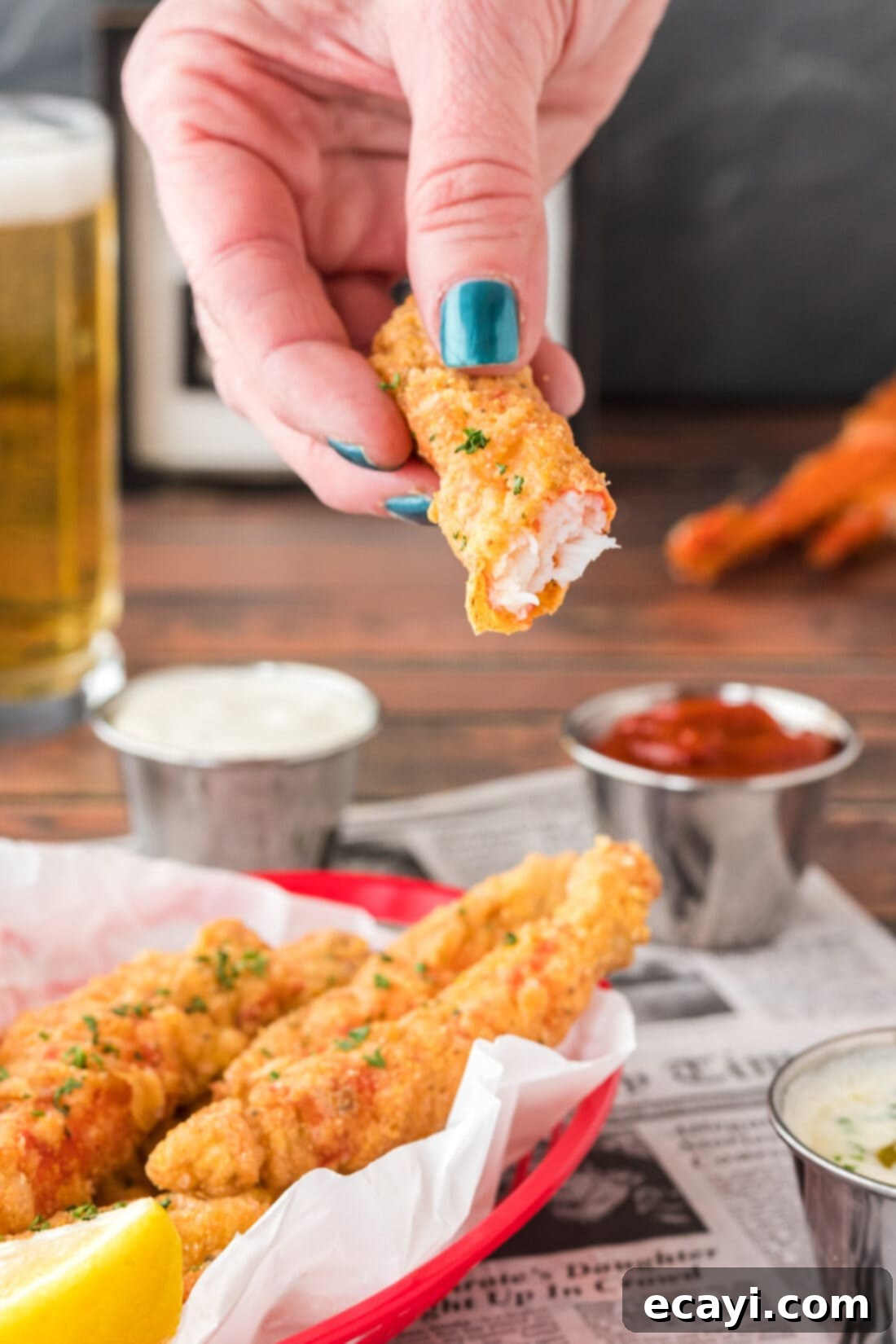
Delicious Serving Suggestions for Fried Crab Legs
These crispy fried crab legs are incredibly versatile and can be enjoyed in a multitude of ways. Whether you’re planning an elegant dinner or a casual appetizer spread, they are sure to be a hit.
As a Main Course: Make these fried crab legs the star of your meal. They pair wonderfully with classic Southern-inspired sides such as creamy mashed potatoes, sweet corn on the cob, a vibrant coleslaw, or fluffy rice. A squeeze of fresh lemon juice over the top adds a bright, zesty finish that truly complements the rich crab flavor.
As an Appetizer: Cut the crab meat into smaller, bite-sized pieces before frying to create perfect finger foods for entertaining. Serve them with an array of delectable dipping sauces to let your guests choose their favorite flavor combination. Popular choices include tangy Alabama white sauce, classic tartar sauce, a rich garlic butter (perfect for enhancing the natural sweetness of the crab), a zesty cocktail sauce, or even a spicy remoulade. Don’t forget a bowl of seasoned potato wedges or crispy onion rings for an ultimate fried feast.
Explore More Delicious Seafood Recipes
If you love seafood as much as we do, you’re in for a treat! Expand your culinary repertoire with these other fantastic seafood dishes that are sure to become family favorites:
- Creamy Crab Dip: A decadent appetizer perfect for gatherings.
- Classic Crab Cakes: Golden-brown and packed with sweet crab meat.
- Crispy Fried Shrimp: Another fried favorite with a satisfying crunch.
- Perfectly Pan-Seared Scallops: Elegant and quick to prepare.
- Luxurious Steamed Lobster Tail: A simple yet impressive dish.
- Air Fryer Scallops: For a healthier twist on crispy seafood.
I absolutely adore sharing my passion for baking and cooking, along with all my kitchen experiences, with each and every one of you! Remembering to come back and discover new recipes every day can sometimes be a challenge, which is why I’ve made it easy for you. I offer a convenient newsletter that delivers a brand-new recipe straight to your inbox every time a new one is posted. Simply subscribe today and start receiving your free daily recipes, ensuring you never miss out on a delicious creation!

Fried Crab Legs
IMPORTANT – There are often Frequently Asked Questions within the blog post that you may find helpful. Simply scroll back up to read them!
Print It
Pin It
Rate It
Save ItSaved!
Ingredients
- 5 raw King crab leg claws
- 2 large eggs
- 1 Tablespoon hot sauce
- 1 Tablespoon Old Bay seasoning divided
- 1 Tablespoon garlic salt divided
- 1 cup all-purpose flour
- ½ cup yellow cornmeal
- vegetable oil for frying
Things You’ll Need
-
Large heavy bottomed skillet or deep fryer
-
Cut resistant gloves
-
Kitchen scissors
Before You Begin
- King crab legs have sharp, pokey shells. We recommend wearing cut resistant gloves when working with King crab to protect your hands.
- Do NOT use precooked crab legs! Raw crab is essential for the best texture and flavor when deep-frying.
- Consider doubling the recipe if you’re feeding a larger group or simply want more leftovers. When doing so, make sure to fry in batches to avoid overcrowding the pan and ensure even crispiness.
Instructions
-
Add vegetable oil to a large heavy bottomed skillet (or deep fryer) so that it comes 1-inch up the side. Heat over medium-high until oil is shimmering and reaches approximately 350-375°F (175-190°C).
-
Using gloved hands for safety, carefully crack crab legs at the joints, exercising caution not to tear the delicate meat inside. Kitchen shears may be useful for smaller, tougher joints.
-
With kitchen shears, cut open the crab shell lengthwise. Gently open the shell and meticulously remove the crab meat, striving to keep pieces as intact as possible.
-
In a medium bowl, whisk together the eggs, hot sauce, half of the Old Bay seasoning, and half of the garlic salt until thoroughly combined. This is your wet batter.
-
In another medium bowl, combine the yellow cornmeal, all-purpose flour, the remaining Old Bay seasoning, and the remaining garlic salt. Whisk these dry ingredients together well to create your dredging mixture.
-
Dip each piece of crab meat first into the egg mixture, allowing any excess to drip off. Then, transfer it to the flour mixture, ensuring it is fully coated. Gently press the coating to adhere. Place the battered crab on a wire rack and repeat for all remaining crab.
-
Carefully place the coated crab into the hot oil. Fry for 2-3 minutes per side, or until the exterior is golden brown and deliciously crispy. Once cooked, remove and drain excess oil on paper towels before serving immediately.
Expert Tips & FAQs
- Store any leftover fried crab legs in an air-tight container or wrapped tightly in aluminum foil in the refrigerator for up to 4 days.
- To reheat, place them in an air fryer or in an oven preheated to 350°F (175°C) for a few minutes until hot and crispy again. Avoid microwaving to preserve crispiness.
- Always use raw crab legs for frying; precooked crab will become tough.
- Don’t overcrowd the pan when frying; cook in batches to maintain oil temperature and ensure maximum crispiness.
- Wearing cut-resistant gloves is highly recommended when working with sharp King crab shells.
Nutrition
The recipes on this blog are tested with a conventional gas oven and gas stovetop. It’s important to note that some ovens, especially as they age, can cook and bake inconsistently. Using an inexpensive oven thermometer can assure you that your oven is truly heating to the proper temperature. If you use a toaster oven or countertop oven, please keep in mind that they may not distribute heat the same as a conventional full sized oven and you may need to adjust your cooking/baking times. In the case of recipes made with a pressure cooker, air fryer, slow cooker, or other appliance, a link to the appliances we use is listed within each respective recipe. For baking recipes where measurements are given by weight, please note that results may not be the same if cups are used instead, and we can’t guarantee success with that method.
